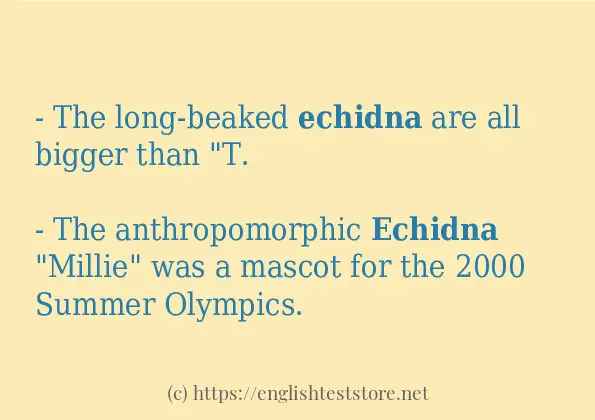How to use in-sentence of “echidna”:
– The long-beaked echidna are all bigger than “T.
– The anthropomorphic Echidna “Millie” was a mascot for the 2000 Summer Olympics.
– Knuckles the Echidna is a popular character from the Sonic the Hedgehog video game franchise, debuting in Sonic the Hedgehog 3.
– At a metre long, it was huge for an echidna and for monotremes in general.
– The short-beaked echidna eats termites and ants.
– This has conservation implications for the endangered species of echidna from the genus “Zaglossus”, and to a lesser extent for the Short-beaked Echidna.
– It is closer in size to the short-beaked echidna than other members of the genus.

Example sentences of “echidna”:
– Together with her brother Phorcys she bore the Gorgons, and Graeae, Echidna and Ladon.
– The hippocampus has a generally similar appearance across the mammals from monotremes such as the echidna to primates such as humans.
– It has a special nose and a special tongue that lets the echidna catch its prey at a great speed.
– Responses of mechanoreceptors and thermoreceptors in skin of the snout of the echidna “Tachyglossus aculeatus”.
– The Short-beaked Echidna is an iconic animal in modern Australia.
– Like all monotremes, the echidna has only one orifice for the passage of fecesfaeces, urine and reproductive products, which is known as the cloaca.
– Unlike the platypus, which shows no evidence of torpor or hibernation, the body temperature of the echidna may fall as low as 5°C.
- Together with her brother Phorcys she bore the Gorgons, and Graeae, Echidna and Ladon.
- The hippocampus has a generally similar appearance across the mammals from monotremes such as the echidna to primates such as humans.
– The Western long-beaked echidna has about 2,000 electroreceptors on its bill.
– The Short-beaked Echidna is common in most of temperate Australia and lowland New Guinea, and is not listed as endangered.
– The solitary Short-beaked Echidna looks for a mate between May and September; the precise timing of the mating season varies with geographic location.
– The Short-beaked Echidna has been included in several postal issues: it was one of four native species to appear on Australian postage stamps in 1974, where it was the 25 cent stamp; it appeared on a 37 cent stamp in 1987, and again in 1992 when it was on the 35 cent stamp.
– No systematic study of the ecology of the Short-beak Echidna has been published.
